One Crashed Super Tenere
Sometimes, there’s just a little too much “Adventure” in Adventure Touring…
How Tough Is It?
Yamaha has a hit with their new Super Tenere and motorcyclists are clamoring to know more about it.
The Super Tenere and the BMW R1200GS (info), along with the Moto Guzzi Stelvio (info)and review) are the current premier choices for a buyer who wants a shaft-driven dual-sport “Adventure Touring” motorcycle.
The Yamaha newcomer combines the time-tested and proven “trailie” enduro style and ergonomics of the BMW GS-series along with Yamaha’s car-like reliability and adds a new water-cooled motor and typical Japanese attention to detail.
The Super Tenere vs. BMW GS discussion is yet to be decided and each bike includes technological features that are absent or cost extra on the other, but the motorcycle press and owners alike have been praising the bike since its release.
The lucky Super Tenere customers in the countries where the Super-T is being sold seem to love the bike and have reported few problems.
Of course, the BMW, the Guzzi and the Yamaha all weigh too much to be a successful motocrosser or true dirt bike.
Although the Super Tenere weighs nearly as much as a Yamaha FJR1300, it carries the weight low and the bars are wide, so you’d never know it.
As with the BMW GS, there will be a few Super Tenere owners who do laps around the world, but in the hands of the typical owner, the Super-T will probably be subjected to rough gravel roads and dirt trails at the worst. And some will fall.
One Super Tenere’s Not-So-Super Adventure
Taking a bike like the Super Tenere out in its element, on a real outback adventure, leads one to think about what might happen in the event of an actual crash. Just how survivable is it?
The Super Tenere looks like it’s supposed to survive being dumped on its side and Yamaha offers a crash bar set for 245 Euros. I’m sure many accessory manufacturers will offer a full range of gear to equip this bike as it becomes more popular.
BMW owners have relied on rugged crash bars and solid side boxes for years for both form and function, so what might happen to a Super-T when equipped with this optional protection?
Just by coincidence, I found a hint during a recent trip, which found me poking around in an Irish motorcycle shop: Megabikes, located in the center of Dublin, Ireland.
Ciaran Hayes owns the dealership and he also happens to own a Super Tenere that had been unfortunately involved in a major accident.
The blue 2010 bike had been fitted with crash bars, panniers (side and top boxes) and almost every other accessory in the Yamaha catalog.
At 5’8″ he even ordered the bike with an optional low seat, but then found he could ride with the stock seat on the lower setting.
Ciaran is a friendly guy and he agreed to tell me about the story of the life, death and rebirth of his once well-equipped but now totalled Super Tenere that sits in his shop.

The Road, The Rider and The Accident
Ciaran said that a friend had borrowed the bike for a trip to Morocco, with plans for an epic ride that ended badly.
The road was two-lane asphalt and the place was a fairly gentle right-hand curve of the type that riders love to hit fast; especially a rider with years of international experience on his Yamaha R1.
As things will happen when least expected, this benign-looking curve had a rough patch (visible at the bottom right of the photo above), and a rough patch of road can bite you when you least expect it, as it did in this case.
Africa is not known for low speed limits or strict enforcement of same and an open curve like this could have invited speeds in the range of 80-ish MPH, although the rider doesn’t remember how fast he was actually going.
However, the extent of damage to the Super Tenere and the rider’s injuries reinforce the thought that the bike was beyond the typical American “double nickel” (55 MPH) highway speeds.
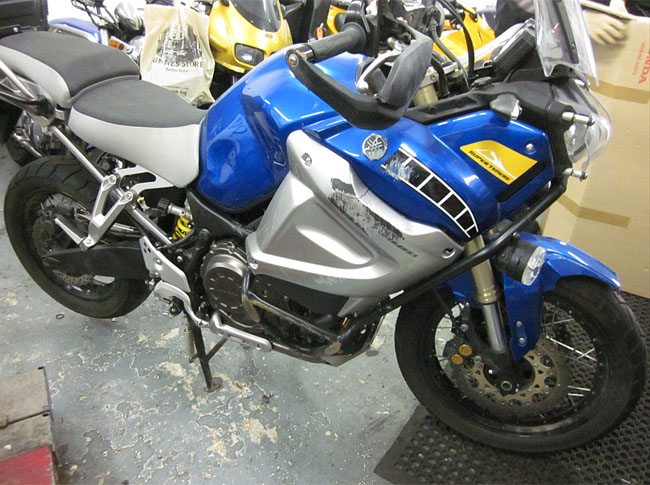
An Accident Reconstruction
Examination of the bike to sort the layering of scratches resulted in a likely sequence of what took place:
There are scuffs on the left sidewall of the rear tire and vertical scratches on the top right of the topbox, as well as the impact-flattened steel tubing of the crashbars.
Rather than simply low-siding out of the gravel, these suggest a highside; lifting the bike and rider, then slamming them down on the right side.
This would also fit with what is known of the rider injuries.
The bike pivoted around to slide nose forward with the handlebar to the right. The bent forks and soft bend to the front wheel rim indicate that it hit something in that orientation, probably the rutted dirt when it left the road.
At some point, the rear wheel absorbed enough of a hit that two spokes were broken.
Ciaran’s friend has no memory of what happened. He awoke in a Moroccan hospital in his riding gear, stripped of money and papers.
The dent in the side of the tank makes it clear that the bike landed on him at some point during the event, because his injuries included a badly broken lower leg.
Fortunately, he had been wearing riding gear that protected against abrasion, which at high speed could have been extensive.
The portion of his face not protected by the open-face helmet was badly hurt and even with the benefits of quality protective gear, the injuries required that he be flown home — a good reason for why you should have medical-flight insurance if riding long distances or in foreign lands.
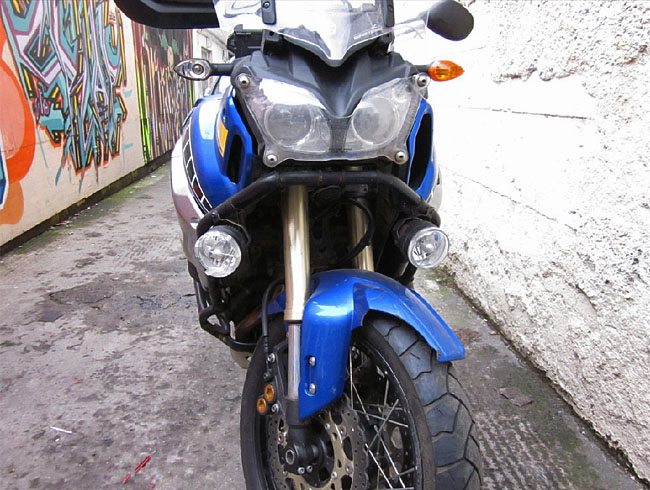
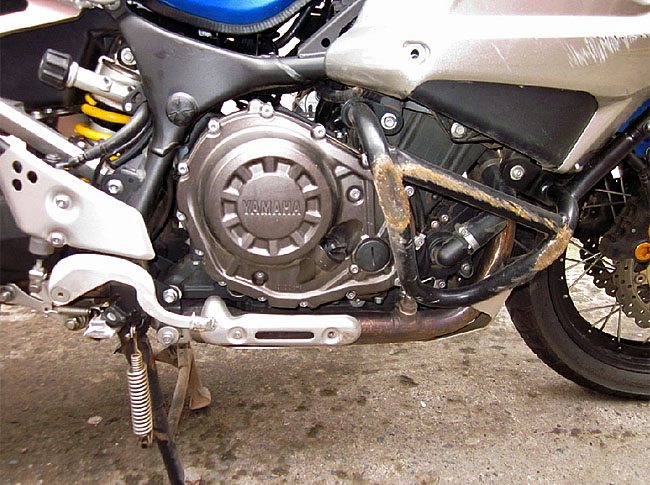
Closer Inspection of the Crashed Super Tenere
The Super Tenere was shipped back to Ciaran’s shop (the last time he lends his bike to a friend, I’d wager!) and the insurance company declared it a total loss from the financial standpoint of making it like new.
But the frame is straight, the bike will run, and from a functional standpoint, it survived.
Looking over the bike, I found that the combination of the optional Yamaha crash bars in front may have protected the rider from even more severe injuries.
Motorcycles since at least the 1930s have been equipped with various types of crash bars and side boxes, and this demonstrates once again that they can provide a survivable space or buffer zone for the rider’s legs in a crash.
The Super Tenere design provides as much leg protection as is practicable for a bike of this type. During the crash, both the top and side boxes were damaged but they held up quite well.
Despite the ruined lid and a broken latch on one side box, it remained locked and the rider’s food stash was still intact when the bike returned to the shop.
[UPDATE (June 2015): I’m now a moderator of the Super Tenere forum and posted this explanation in Post #43 at the bottom of that page (it’s not the post showing the side box at the top of the page).
With what I have learned, the boxes are probably why the lower leg got so badly broken in the first place, and even if they had nothing to do with this one person’s injuries, there is evidence they could be harmful to others.]
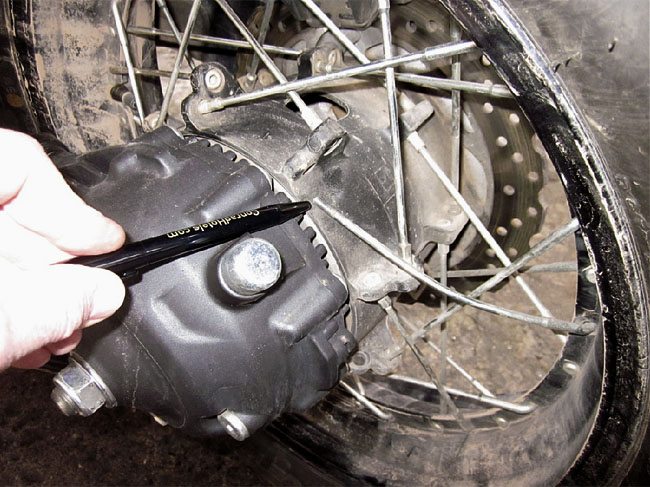
Spokes and Tubes: Old Tech for Rough Times?
Two spokes of the wheel were broken and the front rim had a gentle bend. Any bends in the rear rim were not obvious and I didn’t have time to properly examine how each spoke failed.
The tubeless tires were holding air, partly because the spokes attach to a flange and do not go into the air cavity.
This is an important discovery and demonstrates that one of the benefits of spoked wheels is that even a loss of a spoke or two needn’t be a show-stopper.
Dirt bikers know that a bent rim can be straightened and a tube can still be used to get a spoked wheel — and the rider — back to civilization.
Cast wheels may either survive a crash or break completely, with not much in between. No tube, no way back.
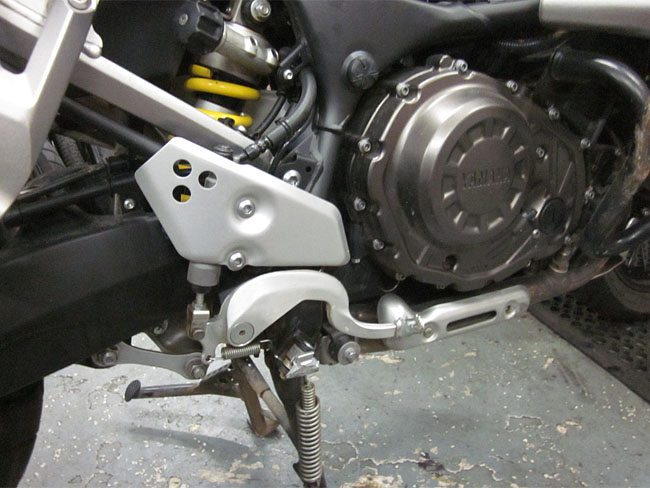
Skid Plate and Fairing
Moving forward along the bike, the crash bars also helped from a technical standpoint, as the engine cases came through without a scratch.
The handlebars Yamaha installed on the Super Tenere also survived both the impact and subsequent grinding.
The skid plate or “bash plate” took hits at some point and it protected the bottom of the engine. I’ve seen photos of two motorcycles ridden hard on unpaved roads and it was apparent that the stock bash plate did not protect the sump.
The lesson here is that there are multiple bash plate options available now and more coming to market, so research these carefully before ordering.
If the crash had been on the left, the side mounted radiator should have been unscathed. From a standing position, the bike can be lowered onto the side, without the plastic body parts touching the ground.
The bike rests on the hand guards, the crash bars and the rear luggage.
While the right-side hand guard of the crashed Super Tenere had rotated down and was almost ground away at the end of the handlebar, it did remain in place to protect the rider’s hands and the handlebar is surprisingly not bent very far from the stock curvature.
So there is probably enough protection for garage tipovers and a slower dirt spills on this bike.
But the Yamaha handlebars clearly don’t cover the upper cosmetics.
The upper fairing parts of the crashed Super Tenere were damaged and it’s easy to see from the front that the plastic body parts can make contact either by rolling the wheels up or as the steel flexes during impact.
This bike rolled far enough that it had heavy road rash on the windshield (which apparently stayed attached), the front brake reservoir and the base of the right mirror.
The bike and rider landed hard enough on the side that even with the protection of the box and bars, the fuel tank has a dent from his knee.
The fairing pieces are certainly not needed for function and we know that they could be fixed or replaced. An extensive accident such as this on a faired road bike typically results in loss of parts that are needed to simply keep the bike running, such as the radiators and engine cases.
Further, designers also have to consider that in many parts of the world, “filtering” (lane splitting) is common and therefore a wider set of bars isn’t needed.
Even so, the expensive damage to the vulnerable plastic was a disappointment and it will be interesting to see how the Yamaha crash bars compare against aftermarket options that are already available.
The right foot peg was broken and the brake lever was bent. Enough of the foot peg remained to rest a boot on and the brake lever looked like it could probably be saved by straightening it.
This is now the second Super Tenere I am aware of where the foot peg has broken off in a crash, and imagining how the bike lays on the right side may provide a clue as to why.
With some engine guard (crash bar) designs, as the bike slides down the road, hitting whatever dips come along, the foot peg assembly and the folded peg may strike the road imperfections.
With a 575-pound bike, this can impart a lot of force. It would be better if the crash bars and bash plate gave more protection to the area around the foot peg mount, something else to consider when outfitting your Adventure Tourer.
Finishing at the front, the forks were bent and the fender was broken and partially missing. The front brake reservoir and the base of the mirror suffered serious road rash. The wheel rim appeared to be slightly bent but like the rear, the tubeless tire was holding air when I saw it.
A new turn signal will be needed and the headlights came through the ordeal intact.
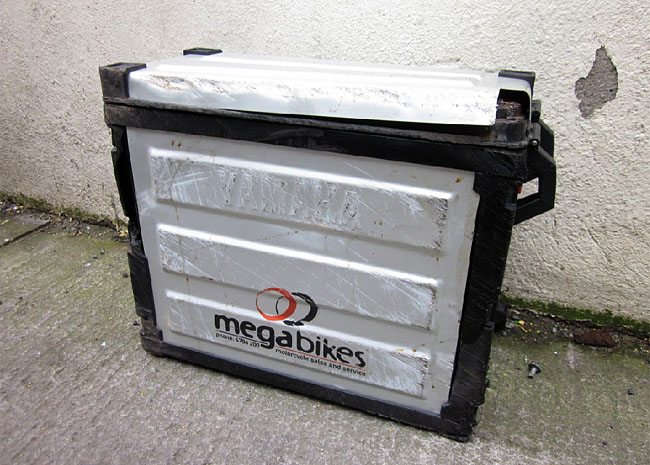
Conclusion
Setting aside the injuries to the rider, it appears that the Super Tenere would still have been ridable after the accident, which happened far away from a populated area.
The wheels turn, the frame is straight, and other than the broken lights, everything works.
The resulting ride back would have been slow, due to the bent forks, footpeg, and wheel damage, but the Super Tenere probably would not have stranded its rider.
The bike only has about 5,000 km (3,000 miles) on the odometer and Ciaran had grown to really like it.
Since the accident, he and the friend who had the accident have purchased the bike back from the insurance company and are starting to replace what they need for it to be roadworthy and to give it a like-new appearance.
This Super Tenere is going to go on more adventures that will hopefully end with better memories.
More wBW Motorcycle Reviews | All wBW Motorcycle Product Reviews
Owner Comments and Feedback
See details on submitting comments.
From “T.G.” (03/11): “I really hope the rider is ok and rebounds back to be back on two wheels soon. Glad to see the bike also takes a crash gracefully.
Although I do question these “adventure” motorcycles as I have taken even big 900 pound large touring bikes like the Yamaha Venture from the 80’s and 90’s down rough gravel roads and the solid packed dirt two track to camp at a rustic site.
It’s 90% rider skill and 10% bike for “adventure” riding.
Granted if you want a refined aggressive looking ride for the highways, these bikes are the way to go, but they are no more capable off road than any other road bike.
I have followed buddies through the bush without problems on a FJR1300 and will happily pop over a curb and ride across the grass to get around an obstacle.
But I also have been on Dirt-bikes ever since I could walk. Although I will be the first to admit my FJR would utterly explode into a pile of broken plastic in that same crash, that’s the price you pay for “aerodynamic”.”
From “R.K.” (03/11): “Just read your article regarding the Tenere Crash. Being an avid Motorcyclist myself, my first concern would be to Ciaran’s Friend.
Hopefully he is healing well and will not sustain any permanent injuries from the crash. It is my opinion that the bike can be replaced, not the person.
The Tenere seems to have taken the crash with dignity and although it was written off by insurance, I am even more impressed that the major components of the bike survived the crash such as the engine, frame and related drive system.
I am currently on the waiting list for a New US Bound Tenere and continually impressed by the reviews this bike has been receiving in the European community.
I am not brand loyalist and have owned various manufacturers of bikes including BMW and I wanted to point out what seems to be an inaccuracy in a comment that was made in the article.
The article made the following statement; “While the Super Tenere may not have some of the technology that BMW owners pay for, the motorcycle press and owners alike have been praising the bike”.
The main reason that attracted me to the Tenere was that fact that it exceeded the technology that is available on the BMW GS at a lower cost that comes standard on the Tenere and optional on the BMW.
I love the GS, but what’s not to like on the Tenere. I think the Tenere is a real winner and I’m glad it’s coming to North America.”
Bob’s Reply: There was no insinuation that the Yamaha isn’t a high-tech bike, because it has a number of high tech features, such as the traction control and ABS.
What was meant was very close to what the one commenter guessed, in that the Yamaha doesn’t incorporate some items like Telelever, Paralever, the standard immobilizer theft deterrence, single-wire (CANBUS) electric system, and some of the BMW options.
While those may be attractions to some, they can also be seen as negative points and deter others from wanting a bike that has those features.
For example, the theft-deterrent system can be seen as either keeping the bike from being stolen on the positive side, or as a potential failure point from the negative one.
Do you like apples or bananas, Chevy or Ford?”
From “C.C.” (03/11): “Just enjoyed your article “One Crashed Super Tenere”. Quite the account of a bike gone down. Thanks for the thorough review and your thoughts on how the bike handled the crash, etc.
I did have one question regarding your statement “While the Super Tenere may not have some of the technology that BMW owners pay for, the motorcycle press and owners alike have been praising the bike.”
In one of the forums, I theorized that maybe you meant the Super Tenere has certain technology included in the price for which BMW owners have to pay extra since I couldn’t think of any technology that the BMW 1200GS and GSA had, or offered, that was a technological advantage for a dual sports.
The Super Tenere has ABS (that works and doesn’t need an off switch), linked brakes, full display computer (option on the BMW), 2 levels of traction control plus off (not available on BMW), two engine mapping modes — sport and touring (not available on BMW),
It’s liquid cooled, fuel injected, shaft drive (that, so far, hasn’t burned up), lower center of gravity for lighter feel, etc. etc.
One can order heated grips if you want as is the case with the BMW.
So, the Super Tenere come standard with everything, and more, than the BMWs have, or can have.
This make me curious as to what “technology” is missing? Telelever suspension? A good road suspension setup that works less than ideal on rough off-road (hence why the HP2 didn’t have Telelever front suspension).
The GS do offer an option of switch-adjustable suspension. I have no interest in it, but some might like it I suppose.
Chromed exhaust pipe is the only other BMW option that I can think of. Ha. So, just thought I’d ask so I wasn’t speculating and could fully understand what technology the Super Tenere is lacking compared to the BMW GS.
Keep up the great work and thanks for a great article on the crash worthiness of the Super Tenere. Very unique report as most of them are simple riding reports.”
Other WebBikeWorld Motorcycle Brands Posts



No Comment